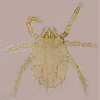Research Progress on Leptotrombidium deliense
- PMID: 30196663
- PMCID: PMC6137299
- DOI: 10.3347/kjp.2018.56.4.313
Research Progress on Leptotrombidium deliense
Abstract
This article reviews Leptotrombidium deliense, including its discovery and nomenclature, morphological features and identification, life cycle, ecology, relationship with diseases, chromosomes and artificial cultivation. The first record of L. deliense was early in 1922 by Walch. Under the genus Leptotrombidium, there are many sibling species similar to L. deliense, which makes it difficult to differentiate L. deliense from another sibling chigger mites, for example, L. rubellum. The life cycle of the mite (L. deliense) includes 7 stages: egg, deutovum (or prelarva), larva, nymphochrysalis, nymph, imagochrysalis and adult. The mite has a wide geographical distribution with low host specificity, and it often appears in different regions and habitats and on many species of hosts. As a vector species of chigger mite, L. deliense is of great importance in transmitting scrub typhus (tsutsugamushi disease) in many parts of the world, especially in tropical regions of Southeast Asia. The seasonal fluctuation of the mite population varies in different geographical regions. The mite has been successfully cultured in the laboratory, facilitating research on its chromosomes, biochemistry and molecular biology.
Keywords: Chigger mites; Leptotrombidium deliense; ecology; life cycle; scrub typhus; vector.
Conflict of interest statement
The authors declare they have not conflict of interest.
Figures
Similar articles
-
[Preliminary survey on the distribution of Leptotrombidium deliense in some areas of Yunnan province].Zhonghua Liu Xing Bing Xue Za Zhi. 2011 Jan;32(1):13-6. Zhonghua Liu Xing Bing Xue Za Zhi. 2011. PMID: 21518533 Chinese.
-
Research Advances of Leptotrombidium scutellare in China.Korean J Parasitol. 2021 Feb;59(1):1-8. doi: 10.3347/kjp.2021.59.1.1. Epub 2021 Feb 19. Korean J Parasitol. 2021. PMID: 33684981 Free PMC article. Review.
-
Relative Abundance of a Vector of Scrub Typhus, Leptotrombidium sialkotense, in Southern Yunnan Province, China.Korean J Parasitol. 2020 Apr;58(2):153-159. doi: 10.3347/kjp.2020.58.2.153. Epub 2020 Apr 30. Korean J Parasitol. 2020. PMID: 32418384 Free PMC article.
-
Leptotrombidium (Leptotrombidium) Umbricola, new species, a probable vector of scrub typhus in Peninsular Malaysia.Jpn J Med Sci Biol. 1980 Oct;33(5):277-82. doi: 10.7883/yoken1952.33.277. Jpn J Med Sci Biol. 1980. PMID: 7300039
-
Current status of mites and mite-borne diseases in India.J Vector Borne Dis. 2023 Jan-Mar;60(1):1-10. doi: 10.4103/0972-9062.361175. J Vector Borne Dis. 2023. PMID: 37026214 Review.
Cited by
-
The impact of meteorological parameters on the scrub typhus incidence in Baoshan City, western Yunnan, China.Front Public Health. 2024 Apr 24;12:1384308. doi: 10.3389/fpubh.2024.1384308. eCollection 2024. Front Public Health. 2024. PMID: 38721542 Free PMC article.
-
Screening and genotyping of Orientia tsutsugamushi from field-collected on-host chiggers (Acari: Prostigmata) recovered from a positive scrub typhus locality in Kelantan, Malaysia.Exp Appl Acarol. 2021 May;84(1):171-182. doi: 10.1007/s10493-021-00609-3. Epub 2021 Apr 7. Exp Appl Acarol. 2021. PMID: 33826009
-
The epidemiology, diagnosis and management of scrub typhus disease in China.Hum Vaccin Immunother. 2021 Oct 3;17(10):3795-3805. doi: 10.1080/21645515.2021.1934355. Epub 2021 Jun 14. Hum Vaccin Immunother. 2021. PMID: 34124995 Free PMC article.
-
Intraspecific sensilla dimorphism in Ascoschoengastia indica (Prostigmata, Trombiculidae).Heliyon. 2024 Jul 2;10(14):e33908. doi: 10.1016/j.heliyon.2024.e33908. eCollection 2024 Jul 30. Heliyon. 2024. PMID: 39100469 Free PMC article.
-
Ecological and behavioural risk factors of scrub typhus in central Vietnam: a case-control study.Infect Dis Poverty. 2021 Aug 19;10(1):110. doi: 10.1186/s40249-021-00893-6. Infect Dis Poverty. 2021. PMID: 34412700 Free PMC article.
References
-
- Strickman D. Scrub typhus. In: Ashford RW, Service MW, editors. The Encyclopedia of Arthropod-Transmitted Infections. New York, USA: CABI Publishing; 2001. pp. 456–462.
-
- Zhan YZ, Guo XG, Speakman JR, Zuo XH, Wu D, Wang QH, Yang ZH. Abundances and host relationships of chigger mites in Yunnan province, China. Med Vet Entomol. 2013;27:194–202. - PubMed
-
- Candasamy S, Ayyanar E, Paily K, Karthikeyan PA, Sundararajan A, Purushothaman J. Abundance & distribution of Trombiculid mites & Orientia tsutsugamushi, the vectors & pathogen of scrub typhus in rodents & shrews collected from Puducherry & Tamil Nadu, India. Indian J Med Res. 2016;144:893–900. - PMC - PubMed
-
- Takada N, Yamamoto S, Taira K, Fujita H, Tkahashi M, Ando S, Kadosaka T. High endemicity of deliense-chigger found out on Miyako islands where tsutsugamushi disease cases etiologically associated with Taiwan were diagnosed. J Acarol Soc Jpn. 2011;20:47–48. (in Japanese)
-
- Traub R, Wisseman CL, Jr, Ahmad N. The occurrence of scrub typhus infection in unusual habitats in west Pakistan. Trans R Soc Trop Med Hyg. 1967;61:23–57. - PubMed
Publication types
MeSH terms
LinkOut - more resources
Full Text Sources
Other Literature Sources
Research Materials





